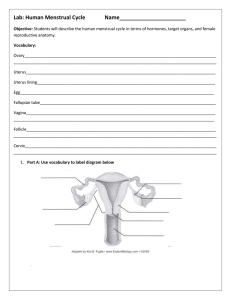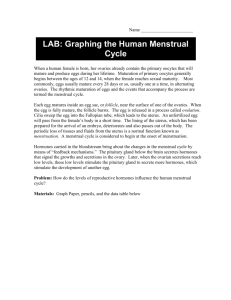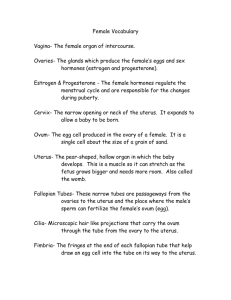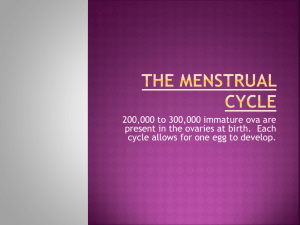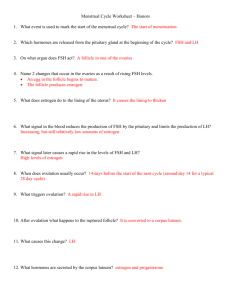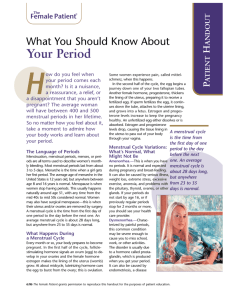File - Ms. Poole's Biology
advertisement
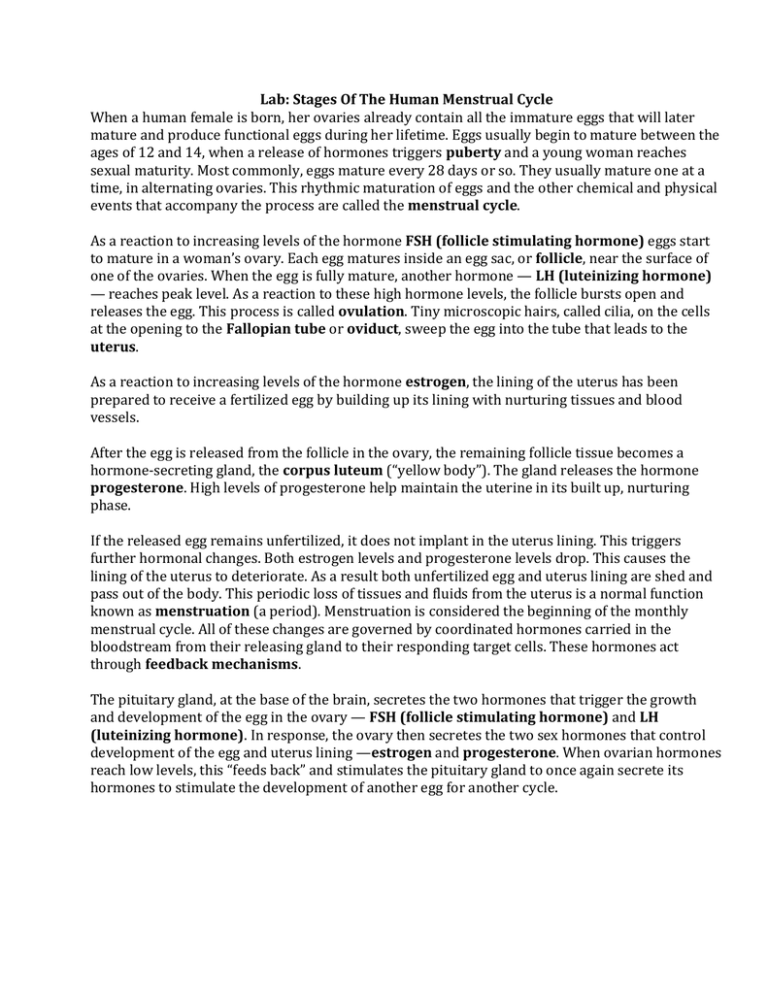
Lab: Stages Of The Human Menstrual Cycle When a human female is born, her ovaries already contain all the immature eggs that will later mature and produce functional eggs during her lifetime. Eggs usually begin to mature between the ages of 12 and 14, when a release of hormones triggers puberty and a young woman reaches sexual maturity. Most commonly, eggs mature every 28 days or so. They usually mature one at a time, in alternating ovaries. This rhythmic maturation of eggs and the other chemical and physical events that accompany the process are called the menstrual cycle. As a reaction to increasing levels of the hormone FSH (follicle stimulating hormone) eggs start to mature in a woman’s ovary. Each egg matures inside an egg sac, or follicle, near the surface of one of the ovaries. When the egg is fully mature, another hormone — LH (luteinizing hormone) — reaches peak level. As a reaction to these high hormone levels, the follicle bursts open and releases the egg. This process is called ovulation. Tiny microscopic hairs, called cilia, on the cells at the opening to the Fallopian tube or oviduct, sweep the egg into the tube that leads to the uterus. As a reaction to increasing levels of the hormone estrogen, the lining of the uterus has been prepared to receive a fertilized egg by building up its lining with nurturing tissues and blood vessels. After the egg is released from the follicle in the ovary, the remaining follicle tissue becomes a hormone-secreting gland, the corpus luteum (“yellow body”). The gland releases the hormone progesterone. High levels of progesterone help maintain the uterine in its built up, nurturing phase. If the released egg remains unfertilized, it does not implant in the uterus lining. This triggers further hormonal changes. Both estrogen levels and progesterone levels drop. This causes the lining of the uterus to deteriorate. As a result both unfertilized egg and uterus lining are shed and pass out of the body. This periodic loss of tissues and fluids from the uterus is a normal function known as menstruation (a period). Menstruation is considered the beginning of the monthly menstrual cycle. All of these changes are governed by coordinated hormones carried in the bloodstream from their releasing gland to their responding target cells. These hormones act through feedback mechanisms. The pituitary gland, at the base of the brain, secretes the two hormones that trigger the growth and development of the egg in the ovary — FSH (follicle stimulating hormone) and LH (luteinizing hormone). In response, the ovary then secretes the two sex hormones that control development of the egg and uterus lining —estrogen and progesterone. When ovarian hormones reach low levels, this “feeds back” and stimulates the pituitary gland to once again secrete its hormones to stimulate the development of another egg for another cycle. INSTRUCTIONS Part A. Hormones of the Menstrual Cycle and Their Effects 1. Look at the charts of Figure 1. Notice that there are four charts and each chart has an X-axis and Y-axis like a graph. A. Hormones from the Pituitary Gland in the Brain B. Events in Ovary (Egg Development) C. Sex Hormones from the Ovary D. Events in the Lining of the Uterus 2. FSH: Using the data in Table 1, plot the points in Chart A to track the concentrations of FSH (follicle-stimulating hormone) released by the pituitary gland into the blood. Be sure to use the left-hand scale on the graph. Draw a smooth curve-of-best-fit rather than just connecting the dots. 3. LH: Using the data in Table 1, plot the points in Chart A to track the concentrations of LH (luteinizing hormone) released by the pituitary gland into the blood. Be sure to use the righthand scale on the graph. Draw a smooth curve-of-best-fit rather than just connecting the dots. 4. Estrogen: Using the data in Table 1, plot the points in Chart C to track the concentrations of estrogen released by the ovary into the blood. Be sure to use the left-hand scale on the graph. Draw a smooth curve-of-best-fit rather than just connecting the dots. 5. Progesterone: Using the data in Table 1, plot the points in Chart C to track the concentrations of progesterone released by the ovary into the blood. Be sure to use the right-hand scale on the graph. Draw a smooth curve-of-best-fit rather than just connecting the dots. PART B. ANATOMY 1. Review the anatomy of the human female reproductive system. 2. Label the diagram below with the following terms: a. Ovary: the female reproductive organ in which eggs are produced. It also acts as a gland and secretes estrogen and progesterone sex hormones. b. Uterus (womb): the muscular organ in which a fetus develops and is nurtured during pregnancy. c. Uterus lining: the inner tissue in the uterus that builds up in preparation for the implantation of a fertilized egg. It is rich in blood vessels to nurture the embryo. d. Egg (ovum): female sex cell with one copy of the mother’s genes. e. Fallopian tube (oviduct): two very thin tubes that serve as a path for the egg from the ovaries to the uterus. (In humans, these are Fallopian tubes; in other organisms they are referred to as ovideucts.) f. Vagina: muscular tube that serves as the birth canal for delivering the baby from the uterus (womb) to the outside world. g. Follicle: tissue in ovary surrounding developing egg. The follicle cells are the cells of the ovary that secrete the hormone, estrogen. h. Cervix: opening of the uterus that leads to the vagina. During birth, the cervix must dilate enough (up to 10 cm or ~4 inches) to allow the baby to pass through. Part C. The Calendar of the Menstrual Cycle In this section we will explore the events of the menstrual cycle across a calendar month to relate the internal stages of the menstrual cycle to the days of the month. 1. Menstrual Cycle: No Fertilization of Egg 1. At the back of this packet you will find a series of symbols in squares labeled Figure 2A “No Fertilization of Egg.” These diagrams show different stages that occur during the menstrual cycle if fertilization does not occur. 2. Look over the calendar marked Figure 2B. It describes the series of events that take place in the female reproductive system if fertilization does not occur. 3. Cut out the squares from Figure 2A and match them with the events on the calendar. Place the square to the right of the bracket (in an empty day) for the event that properly describes it. Note: Not all calendar boxes will be filled in. 4. When all squares have been properly matched to events, tape them onto the calendar in their proper location. 2. Menstrual Cycle: Fertilization of Egg Does Occur 1. At the back of this packet you will find a series of symbols in squares labeled Figure 3A “Fertilization of Egg.” These diagrams show different stages that occur during the menstrual cycle if fertilization does occur. 2. Look over the calendar marked Figure 3B. It describes the series of events that take place in the female reproductive system if fertilization does occur. 3. Cut out the squares from Figure 3A and match them with the events on the calendar. Place the square to the right of the bracket (in an empty day) for the event that properly describes it. Note: Not all calendar boxes will be filled in. 4. When all squares have been properly matched to events, tape them onto the calendar in their proper location. Analysis Questions 1. Include your graphs of FSH and LH, and estrogen and progesterone. (5 points) 2. If the picture below is illustrating a cell secreting a hormone, then draw what the receptors would look like on the target cell in the ovary. (2 points) 3. FSH questions (3 points) a. What gland secretes FSH (follicle-stimulating hormone)? b. On what day does the FSH reach its peak concentration? c. What happens to the egg follicle in the ovary as FSH rises (during Days 1-12)? 4. Estrogen questions (3 points) a. What gland secretes estrogen? b. On what day does the estrogen reach its peak concentration? c. What happens to the uterus lining during days 1-12 days, as estrogen is rising? 5. LH questions (3 points) a. What gland secretes LH (luteinizng hormone)? b. On what day does the LH reach its peak concentration? c. What happens to the egg in the ovary on Day 14 after LH levels reach their peak? 6. Progesterone questions (3 points) a. On Day 14 the egg is released (ovulation). After that, the corpus luteum forms in the remaining follicle, and it starts releasing progesterone. On what day does the progesterone reach its peak concentration? b. While progesterone stays at a high level, what happens to the lining of the uterus? c. If the woman does not get pregnant, then the corpus luteum breaks down and the level of progesterone starts declining. Once progesterone decreases, what happens to the lining of the uterus? What process is occurring between Days 3 – 6? 7. What is the difference between fertilization and pregnancy, in terms of process and location? (2 points) 8. Why does the ‘morning-after’ pill act as contraception, even if it is used after fertilization occurs? (2 points) 9. How does knowledge of the menstrual cycle offer opportunities for birth control and contraception? (2 points) 10. Many birth control pills and contraceptive methods work by delivering a low dose of either estrogen and progestin (a form of progesterone), or progestin alone. How does delivering low doses of these hormones act as contraception? (You may need to do some research!) (5 points)

